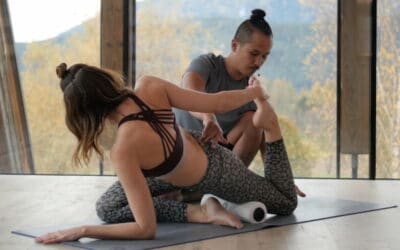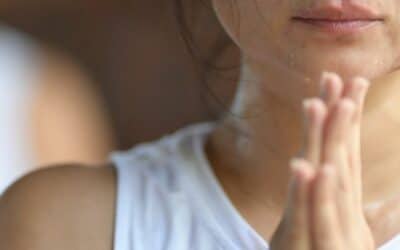Five syllables that make every yoga student sigh and every yoga teacher feel like a drill instructor: ut-ka-ta-sa-na, an asana also known as Chair pose, Awkward Pose or Fierce pose.
While your quads scream and your core muscles fire up, don’t forget to pay attention to your Chair pose alignment. Especially since the knees are in a very vulnerable position, it bears the risk of causing knee pain. Furthermore, compressing the lumbar spine can turn this asana into the culprit for back pain.
“Chair pose is a defiance of spirit, showing how high you can reach even when you’re forced down.”
This article will help you to understand proper Chair pose alignment:
1. How Do You Get Into Utkatasana (Chair Pose)?
- Start in Mountain pose (Tadasana) with your feet hip-width apart.
- Bend your knees and start to lower your hips to sit into the pose. Picture an imaginary chair behind you (be it a bar stool or a kitchen chair).
- Open your chest and raise your arms up overhead. Keep your arms open with the palms facing.
- Engage your feet by lifting the toes up. Spread them and try to bring your big toes and pinky toes down on the ground. Really push your big toes into the mat.
- Widen your knees and, at the same time, inwardly rotate your thighs. There is no actual movement involved in this action, but your legs become really engaged.
- Create a gentle curve in your lower back while simultaneously stretching out the front body.
- Lift your chest and shoulder blades up. Outwardly rotate your upper arms to avoid shoulder impingement.
- Note that Utkatasana is a gentle backbend. This means that you want to feel a stretch on the front side of your body.
- Shift your weight slightly backward and tilt your pelvic floor to the front (anterior tilt). The curve in your lumbar spine will thus be more pronounced.
- Lengthen and lift up your ribcage.
- Lift up your chin slightly without hyperextending the neck.
- Don’t forget to smile – this will make the pose a lot easier!
Time to practice: Follow Young Ho Kim‘s step-by-step instructions in his Inside Yoga Alignment on TINT to get the most out of your Chair pose.
Learn Chair pose with Inside Yoga Alignment on TINT.
2. What Is Your Body Doing In Utkatasana (Chair Pose)?
2.1. What Are the Joints Doing?
Let’s have a look at your joints’ alignment in Chair pose: The axial extension of the spine is continued in the straightened arms due to the extension of the elbows.
The scapulae are in upward rotation and, at the same time, abducted and elevated while the shoulder is flexed.
The hip and the knees are flexed and there’s dorsiflexion in the ankles.
2.2. Which Muscles Are Engaged?
There is quite a number of muscle groups working in your spine to maintain its alignment, such as the transversospinalis (the deep muscles along your vertebral column) and the erector spinae. The psoas minor and the abdominal muscles are contracting concentrically to prevent overextension of the lumbar spine.
In the upper limbs, the upper trapezius and the serratus anterior contract in order to effect the upward rotation, abduction and elevation of the scapulae. In addition, the latissimus dorsi plays an important role here: The action of lifting the arms overhead can be limited if this muscle is too short.
The rotator cuff muscles, the pectoralis muscles as well as the biceps brachii and the anterior part of the deltoids help to stabilize and flex the shoulder joint.
The triceps brachii and the anconeus (a small muscle located at the elbow joint) are responsible for the extension of the elbow.
Moving down to the lower limbs, we find the adductor muscles helping to keep the knees stable and prevent them from falling out too much. Because the knees are partly flexed, they are very mobile and vulnerable in this position and need extra stabilization. The hip and knee flexion as well as the ankle dorsiflexion are effected by way of eccentric contraction of the gluteus muscles, the hamstrings at the hip joint, the vastii muscles in the thigh, and the intrinsic muscles of the foot.
Utkatasana (Chair pose) is an interesting pose to explore a balance between effort and release since it is gravity rather than the muscles working against each other that should be the main source of resistance.
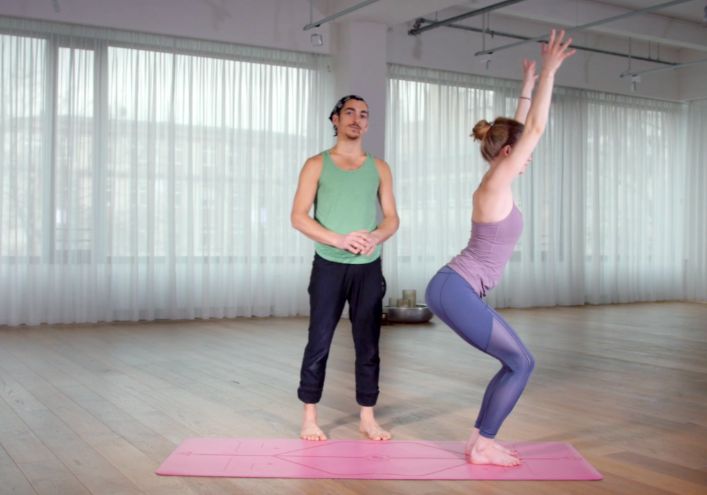
Practice Utkatasana (Chair pose) with Matt Giordano’s Detox Flow on TINT.
If you’re looking for answers to alignment questions regarding other yoga poses, check out our free yoga asana ebook. It will give you a sound understanding of the proper alignment in 10 of the most common yoga asanas and will make a huge difference to your yoga practice.
3. How Do You Get The Correct Alignment in Utkatasana (Chair Pose)?
Traditionally, Utkatasana (Chair pose) is practiced with the feet together and the palms touching. The pelvic floor is tilted backwards and the ribcage is closed.
However, when your feet are together, the hip joint is very narrow so that it has only limited range of motion. This is why you want to bring your feet hip-width distance apart, which is a more anatomical alignment for your hip joint. At the same time, push your knees outward and inwardly rotate the thighs.
The next thing to pay attention to is the pelvis: Instead of tilting the pelvic floor backward, bring it into an anterior tilt. This is because the most common cause for back pain is not too much forward tilting but rather too much backward tilting.
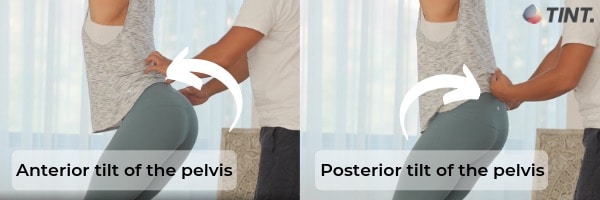
Tilt the pelvis anteriorly in Utkatasana (Chair pose).
However, when you tilt your pelvis forward, you don’t want to collapse and compress your lumbar spine. Lengthen through the sides of your body instead and lift your ribcage up.
Moreover, keeping the hands together leaves not enough space in your shoulder area and will, thus, let the shoulders and the lower back collapse. So, open your hands up and don’t pull your shoulder blades down. Lift them up to the ears instead. This will create more space in your lumbar spine and you will have a soft curve your spine.
Although Utkatasana (Chair pose) is a gentle backbend, it is not a backbend for your head and neck, but for your heart. There is a slight curve in your neck, but no wrinkles. So, instead of dropping the head backward, just lift your chin up a little bit.
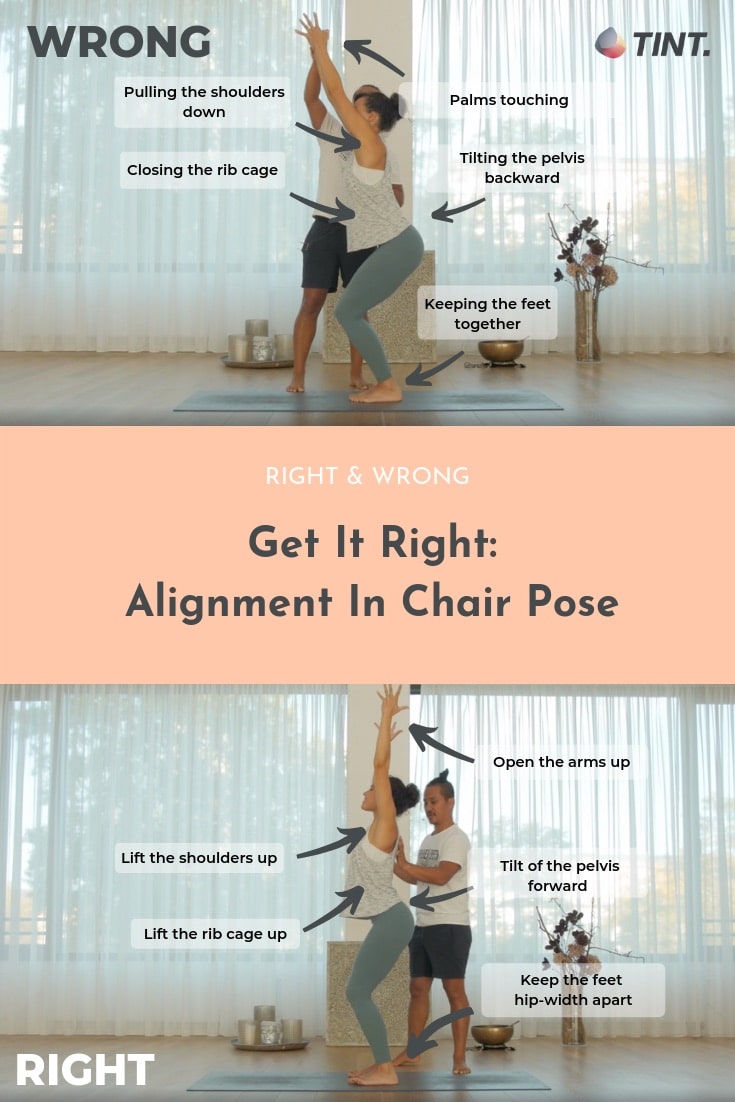
Understand Chair pose alignment with Young Ho Kim’s Inside Yoga Alignment on TINT.
4. How Can You Adapt Utkatasana (Chair Pose) To Your Yoga Practice?
If Utkatasana is a new and challenging yoga pose for you, approach it by practicing Chair pose in separate steps:
- Practice the lower half of your body before involving the arms. So, work on bending the knees toward a 90 degree angle while shifting the body weight back into the heels. You can also practice this near a wall with your back facing the wall and standing a few inches away from the wall. Adjust your position so that your tailbone touches the wall when you bend into the position. This will give you extra support.
- Work on straightening the arms up in Mountain pose (Tadasana). In this position, it’s easier to not let the rib cage pop forward and avoid overarching the back.
- Finally, bring the two elements together by uniting the work of the legs and arms. Bring your awareness to your torso as you lift your rib cage and lengthen your spine.
You can also try different variations of Chair pose to adjust this asana according to the needs of your body:
Lifting the arms overhead demands stamina in this pose. If you feel exhausted, try bringing your arms straight out in front or down by your sides.
To make this pose more accessible for your knees, you can shift your body weight back onto your heels. This will relieve your knees and keep them safe. Don’t let your knees extend forward past your toes.
To lift up your chest and move it away from your thighs, it can be helpful to imagine you’re leaning the entire torso against a wall behind you.
In order to not stress your neck, keep the head and neck in line with the spine. Rather than looking up to the ceiling, let your gaze rest on the floor a few feet in front of you.
If you want to challenge yourself and want to increase the strength of your quads, try squeezing a block or thick book between your thighs during Chair pose. You can also lift up onto the balls of your feet and bring your buttocks down onto your raised heels.
To make Utkatasana less challenging, let your hands rest on your knees or practice it with the feet wider than hip-width apart to create a more stable base.
You can also experiment with the position of the arms: If you clasp your hands behind your back, you will get a nice shoulder stretch. From there, you can bow down into a forward fold.
Another variation is bringing the palms together into a prayer position with the thumbs facing the chest (Anjali Mudra). From there, twist to one side and hook your elbow on your opposite thigh for a twisted variation, which is called Revolved Chair pose (Parivrtta Utkatasana).
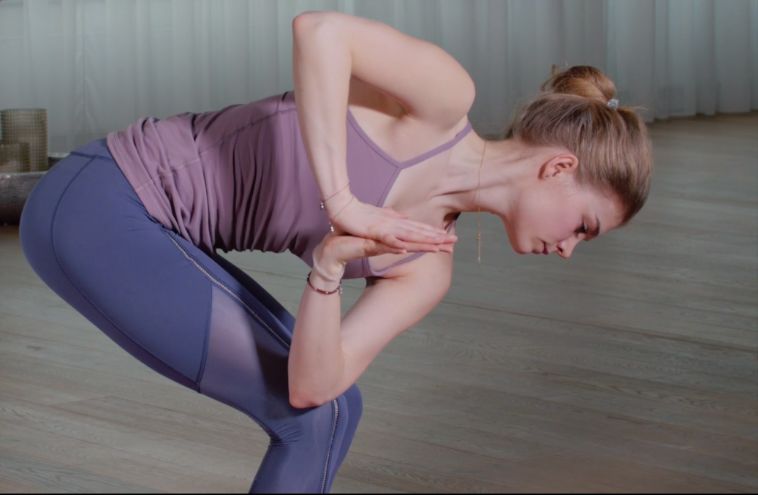
Practice Revolved Chair as a varation of Utkatasana in Matt Giordano’s Detox Flow.
If you want to build Utkatasana or Chair pose into a sequence, you can transition into the pose from Mountain pose (Tadasana) or Crescent Moon (Anjaneyasana).
From Chair pose, you can transition back into Mountain or Crescent Moon, or bow down into a Standing Forward Fold or Half Forward Fold. Furthermore, Utkatasana is a great starting point for a detoxing Revolved Chair pose, as described above.
As already mentioned, proper alignment is king in your yoga practice. To help you with the correct alignment in other yoga poses as well, we have created a free yoga asana ebook for you. It summarizes some the most common yoga poses so you can use it as a reference guide for your practice.
5. What Are the Benefits of Utkatasana (Chair Pose)?
Yes, this asana is not only torture, it has a great deal of benefits! Utkatasana or Chair pose strengthens the entire legs from the glutes and thighs to the calves and ankles. So, if you’re tired of squatting at the gym, you can train your quadriceps with this yoga pose.
Provided that you understand proper Chair pose alignment, it is a great pose for practitioners with knee problems. By building strength in the quads, you’re strengthening the major supporters of vulnerable knee joints. It also strengthens the supporting muscles around other major joints, such as the shoulders, hips, and ankles
However, Chair pose is not only an asana for your legs, it also elongates and lengthens the back and builds vigor in the anterior and posterior spine. Furthermore, this yoga pose helps you develop core strength and build heat in the body. It thus stimulates the abdominal organs, the diaphragm, and the heart.
By lifting the arms up, Utkatasana also works the shoulders and upper back and, at the same time, also opens and stretches the shoulders and chest.
Chair pose is an asana that is really balancing for the pelvis because it helps develop the awareness for the position of the pelvis with the attempt to keep it in a neutral position with the tail neither tucked nor flared.
So, to sum up, Utkatasana or Chair pose helps you to build stamina and tones your entire body – a great workout for body and mind! There is a number of programs on TINT where you can try this yoga pose in class such as Matt Giordano’s Detox Flow or Sianna Shermans Fearless Heart Activation. Start to build some heat in your body!
Feel the heat created by Chair pose in Sianna Shermans Rasa Warrior Practice on TINT.


